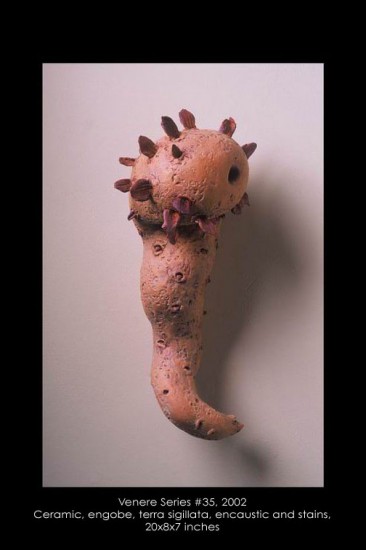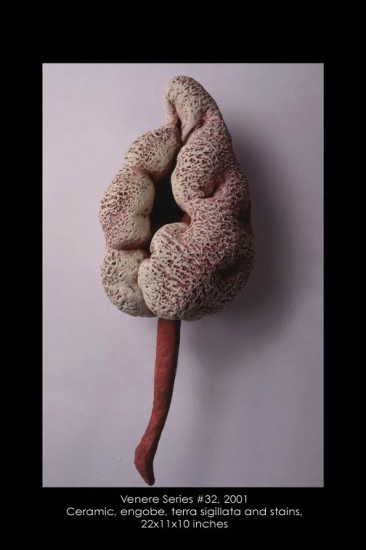“…Radicis creates a mood-altering environment and provides a symbolic map for a thoroughly rational understanding of part of the universe.”
All Posts by Pandra Williams
Chair of Inquiry
Mobile art/science interactive art installation
2 years later…Hurt Park Native Plant Installation
by Pandra Williams
Photos by Cecilia Marrero
Over the past two years, the Hurt Park Native Plant Garden has survived a year of drought, student foot traffic, and a direct hit from a tornado. The erosion, once problematic, is under control where the garden bed has been installed. Many of these perennial plants are now mature, and will continue to fill out and put up additional bloom stalks in the years to come. We have collected seeds from the garden as they ripen for propagation purposes, as well as to make native seed packets.

A tornado in March 2008 hit the newly installed native plant bed.
 Mid summer 2009 in Hurt Park
Mid summer 2009 in Hurt Park
A view of the center flower bed from mid July. Black eyed susan, Rudbeckia fulgida, Brown eyed susan, Rudbeckia triloba,
Purple coneflwer, Echinacea purpurea, and Stokes aster, Stokesia laevis.

Above: Butterfly Weed, Asclepias tuberosa, with a honeybee. This is a host plant for the Monarch butterfly.
 Left: Purple Coneflower, Echinacea purpurea, the same echinacea plant used in herbal cold remedies. Coneflowers will re-bloom if the past prime flower stalks are cut back. This plant is the host for the Silvery Checkerspot Butterfly. In our nursery, later in the summer, we saw goldfinches feasting on the seeds of this plant.
Left: Purple Coneflower, Echinacea purpurea, the same echinacea plant used in herbal cold remedies. Coneflowers will re-bloom if the past prime flower stalks are cut back. This plant is the host for the Silvery Checkerspot Butterfly. In our nursery, later in the summer, we saw goldfinches feasting on the seeds of this plant.
Right: Bluestar, Amsonia tabernaemontana. Pale turquoise, star shaped flowers.A beautiful perennial,not used in the garden nearly enough, Bluestar is the host plant for the Coral Hairstreak butterfly, Satyrium titus. More information can be had at: Butterflies And Moths Of North America and Georgia Wildlife Federation.
Return of the Native Garden
Atlanta Native Plant Project at Hurt Park
During the late 18th century, the Atlanta Piedmont area was covered in rich forests, populated with species of plants and animals that no one from continental Europe or the British Isles had ever seen. The scientific curiosity on the other side of the Atlantic was enormous. Naturalists shot, skinned, picked, dried, drew and cataloged an amazing variety of plant and animal specimens, sending them to both Europe and England.
In the early 19th century, extensive cotton monoculture leveled the forests and obliterated the local plant communities. Without plants, the ecosystems of the Atlanta Piedmont were decimated. In the late 20th century, development compounded the loss of habitat and watershed for all native plants and animals in the Atlanta Metro area. It is now early in the 21st Century. The Atlanta Beltline has spurred enormous greenspace initiatives around the Atlanta Metro area. These initiatives have created hundreds of acres of new restoration possibilities along streams, in newly protected woodlands, and beside trails.
The Hurt Park Native Garden project will allow us to test the hypothesis that drought tolerant native plants create hardy, beautiful landscapes that also carry the benefits of supporting a partial return of the original ecosystem.
The site for the Hurt Park Native Plant garden provides an ideal model for returning the native forbes, or plant species, to the Atlanta area. The selected area is sloped and has been difficult to maintain with common, non-native plants and grasses, but provides an ideal site for a woodland border plant community. Although the plants need an initial watering in period, once these plants are established they will be drought tolerant, and need very little care.
We cannot reconstruct the entire ecosystem that once existed in the Atlanta Metro area. However, with research and perseverance we can restore part of Atlanta’s environmental heritage.
Hurt Park Native Garden Project Team:
Pandra Williams, EcoAddendum
Michael Williams, EcoAddendum
Kathryn Gable, Native Plant Botanical Garden at Perimeter College
Dr. George Sanko, Native Plant Botanical Garden at Perimeter College
Sloane Robinson
Jessica Marshall
Native Sedges provided by and sponsored by Baker Environmental Nursery, Inc.
Arts this is Jack Walsh 07 – 2008
“I met Pandra when we did a segment on the B Complex, and I thought her ceramic sculptures were really compelling. And by compelling, I mean kinda terrifying. She does these tentacled, fanged, slithery forms, disembodied organs, and microscopic critters amplified in scale to nightmarish proportions. Never have I seen sculpture that looks so squishy, yet so menacing.”
Solstice in the Garden

Directions to the Florence Kopleff Recital Hall
- From the North: Take I-85/75 South to the Courtland Street exit (Exit 249A); turn right on Edgewood Avenue; go one block ( Hurt Park is on the left); turn left onto Gilmer Street (a one-way street). The Florence Kopleff Recital Hall is located on your immediate right in the Arts and Humanities building (on the corner of Peachtree Center Avenue and Gilmer Street).
- From the South: Take I-85/75 North to the Edgewood/Auburn Avenue exit (Exit 248B); turn left and continue straight on Edgewood. Go straight one block ( Hurt Park is on the left). Turn left onto Gilmer Street (a one-way street). The Florence Kopleff Recital Hall is located on your immediate right in the Arts and Humanities building (on the corner of Peachtree Center Avenue and Gilmer Street). Parking for The Florence
- Kopleff Recital Hall is available in the I Lot located under the Sciences Annex on Peachtree Center Avenue.
- Riding MARTA: Take the North/South or the East/West line to the Five Points station. Exit toward Peachtree Street. After exiting the station, turn right onto Decatur Street. Go through the first traffic light ( Park Place), and then turn left at the next light ( Peachtree Center Avenue – at Walters’ clothing store). Stay on Peachtree Center Avenue to Gilmer Street (second light) and turn right. The entrance to
Kopleff Recital Hall is immediately on your right.
Fantastical Sculptures 02 – 2008
“interpretations of both plant and planktonic organisms (microscopic algae and protozoa) are eerie and irresistible hybrids.”
Urban Tumulus
Jessica Marshall E., Michael and I made 12,500 pounds of adobe bricks for the Urban Tumulus installation this past July. Earth, sand, straw, water. Each air-dried brick measures 5 inches by 10 inches by 16 inches, and weighs 50 pounds. I don’t know how heavy they were when they were wet and newly unmolded. We made 250 bricks. The weather was damnably hot, bright, and dry, the hottest week of the summer, with temperatures ranging from 98 to 103 degrees. Making adobe is brutal physical labor, each day we needed to make between 35 -45 bricks. At the end of each day we were trashed. All of us who were involved with the project have a deep appreciation for the labor that goes into building an adobe dwelling.
The reddish adobe bricks are made up of Metro Atlanta ’s red clay subsoil. The sanitary mulch was generated from Atlanta Metro yard waste. The Wild Grasses were collected from sidewalks in southwest Atlanta. Drought hardened red clay picked and shoveled and full of debris: broken glass, bits of tiles, broken pieces of rusty metal.
Out of the 12,500 pounds of brick we made, we only used 11,000 pounds of adobe to line the corridor of the Urban Tumulus. At six foot two inches tall, 10 inches wide and about 21 feet long, its not enough adobe to build a one room house. Three pillars, or buttresses, provide additional support in the back. It amazes me how heavy earth is, how Solid. Earth feels reassuring and secure under our feet. Some phrases reflect the reassuring aspect of our relationship to soil. We are “on solid ground.” We can be “well-grounded.” We have “grounds” for a belief, an opinion or theory. The smell of newly tilled soil is wholesome, even comforting. When earth is under foot, all is well.
The tumulus is not underfoot.
Solo Show 2008
Munusculi tantilli – Very small gifts.
About ninety percent of all trees and plants are engaged in life supporting symbiotic exchanges with microscopic fungi at the cellular level in their root systems. Lichens are fungi which host single celled cyanobacteria or algae. Cells of green plants contain chloroplasts, which may also have been cyanobacteria eons ago. The mitochondria of each our own cells may have once originated from a different life form as well.
Life, our human life, is dependent on the tiny gifts of tiny lives. We cannot see most of these organisms, yet they surround us. They are beautiful. Fascinating transparent layers of activity, sheer textures, whispered patterns, organelles and organisms within organism create beautiful forms.
The works of Munusculi tantillum are inspired by the gifts of form and function which surround us, unseen.
Urban earth FAQ, FMC
Kids are great. They don’t ask you what art is- they tell you:
“It’s a cave.”
“It’s a fort. ”
“It’s a castle.”


















